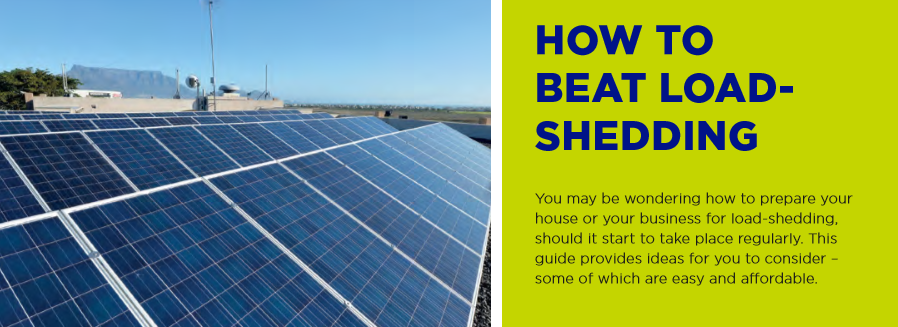What you can do to prepare for load shedding
(Western Cape Government)

What can you do when preparing for Loadsheddding ?
Download your guide or read the full article below:
Do the cheap and easy things first.
1. Check the load-shedding schedule to plan your electricity usage.
Buy a small gas cooker if you don’t already cook with gas. A small gas cooker can cost you R400 - R500. Make sure that the gas cooker meets safety standards.
2. Make sure that your electronics, like your cellphone and laptop, have sufficient battery life.
3. Buy a solar cell charger (about R300), a car phone charger, or a cellphone power bank.
4. Buy rechargeable lights (about R200). They last for up to 10 hours when fully charged.
5. Buy a surge protector plug for your television, computer and fridge. This will protect your appliances when the power comes back on. Depending on the number of sockets required, these range from R100 to R400.
Research ways to “Load-shed Proof” your house
Calculate the daily minimum amount of electricity needed for the household. Do you need the lights, fridge, and TV on? Or only the lights and TV?
• You can then find out how much electricity each appliance needs.
- With lights, identify the wattage of your lights (it is usually printed on the globe itself).
- With appliances, find the labels on the appliance that state the power usage.
Note: kettles and electric stoves use a lot of electricity over a short period of time, so it’s best not to include these. You can rather use a gas stove to heat your water or cook your food. It is also best to exclude your geyser, as it uses a lot of electricity.
Now that you know how much power you will need, find out what the different options will cost you.
Battery
Load-shedding can last for between two and four hours at a time. Therefore, an ideal battery system capacity of five hours should be sufficient.
A battery backup system consists of the following components:
BATTERY CHARGER - Charges the rechargeable batteries from the AC mains power while there is no load-shedding. Note: Sometimes the battery charger is built into the inverter.
INVERTER - Converts the DC battery power into usable AC power during load-shedding. Use an approved inverter. Grid-tied inverters must be registered with the municipality and installed by a qualified person.
BATTERY - Stores the electrical power for later use.
Compliance requirements:
If your battery system is a standalone appliance that you plug devices into, there are no compliance issues.
If your battery system (including inverter) is interconnected with the wiring of your house, it must be declared via the municipality’s SSEG process to confirm that EITHER it is operating safely as an off-grid system OR it is compliant and authorised as a grid-tied system (usually in conjunction with PV). Use an inverter approved by your municipality and installed by a qualified person.
The size of the battery system will depend on the equipment to be powered during load-shedding.
Option 1:
This option is suitable for very limited usage with an average load of 240W. • 4 to 6 LED or Compact Fluorescent lights (CFL) amounting to 24W for LEDs or 45W for CFLs • A TV and a decoder uses 30W when off and 150W when in use • A cell phone charger uses 0.5W not charging and 6W when charging
This option will have a total of 2 x 100 Ah 12V batteries (2 x R 3 000). The inverter can provide 1 000 Watt (10.5A) continuously and 1.2 kWh energy (R9 000). Estimated cost, excluding installation: R15 000
Option 2:
This option is suitable for an average 3-bedroom house where the usage will be limited to an average load of 480W. • 10 to 15 LED or CFL lights • A TV and a decoder uses 30W when off and 150W when in use • One energy-efficient fridge / freezer on, managed well, will consume 100W - 200W • A laptop uses 65W while charging
This option has a total of 2 x 200 Ah 12V batteries (2 x R 6 000). The inverter can provide 2 400 Watt (10.5A) continuously and 2.4 kWh energy (R18 000). Estimated cost, excluding installation: R30 000
Option 3:
This option is suitable for bigger houses, small offices and shops that want to be unaffected by load-shedding. This option will be limited to a load of 960W. • All lighting and a TV will be operational • Multiple fridges and freezers can be operated, but must be opened as little as possible • Laptops and a printer can be used
This option has a total of 4 x 200 Ah 12V batteries (4 x R 6 000). The inverter can provide 4 000 Watt (17 A) continuously and 4.8 kWh energy (R25 000). Estimated cost, excluding installation: R50 000
With all three options, all cooking - including the boiling of water - is achieved using gas and not electricity. In addition, none of these options will be able to power geyser.
A qualified electrician can install the battery and connect it to certain circuits, so that only some items are powered during load-shedding.
Alternatively, you can buy a stand-alone uninterrupted power supply (UPS) backup battery system, which allows you to plug in one or more items (similar to a generator).
Solar PV and Battery
You can install one or more PV panels and store the electricity in a battery. Below are some options, which excludes installation costs.
1. One or two small solar panels and battery that will power 10-20 W (this is equal to a couple of lights and cellphone charger) will cost between R2 000 and R5 000. 2. A large solar panel and a battery that will power 120W (this is equal to about 5 lights or a TV, or a fridge) will cost between R9 000 and R16 000. 3. A 1.5kW - 3kW solar PV system, with batteries, can power 280-305 W (this is equal to a few lights, a TV and a fridge). This is expensive, R50 000+, but in the long run it can save you money on electricity.
If any changes need to be made to your electrical system, make sure that a qualified engineer/electrician installs the system.
In the long term, it is better to invest in battery back-up or solar and battery back-up, rather than investing in a generator. Although a generator may cost less initially, it requires diesel to operate and creates air and noise pollution. Remember that you may not have more than 20 litres of fuel for your generator on your premises. This fuel should be locked in a separate area and you must have a fire extinguisher of at least 4.5 kg on the premises.
Energising the Western Cape BETTER TOGETHER



